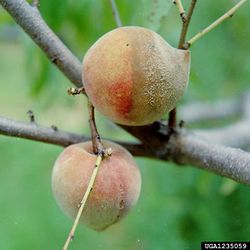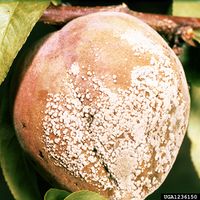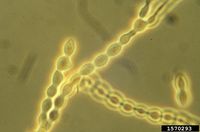Monilinia fructicola
| Literature database |
|---|
| 280 articles sorted by: |
| • year (descending) |
| • research topics |
| • countries/regions |
| • host plants |
| • list of antagonists |

Source: Clemson University - USDA Cooperative Extension Slide Series - IPM Images
Monilinia fructicola (G. Winter 1883)
The fungus causes the economically important disease American brown rot on peach and other stone fruits in many regions. Losses can exceed 50%. Rosaceae, mainly Prunus species, are the main host plants, apples and pears are infected to a lesser extent. Often, it is also a storage problem. Already green fruits may become infected, with the disease remaining dormant until the fruits are mature or in storage. Apart from fruit rot, the fungus can cause blossom blight, twig or leaf blight, and twig canker. The fungus overwinters in mummified fruits which produce condidia and apothecia.
| Vernacular names | |
|---|---|
| • Deutsch: | Fruchtfäule des Kern- und Steinobstes |
| • English: | American brown rot brown rot of stone fruits |
| • Español: | rot-pardo de los frutales |
| • Français: | pourriture brune des fruits |
The conidia are lemon-shaped, measure about 15 x 10 µm and are dispersed by the wind. Apothecia are not common. They are cup-like structures, about 10-20 mm large, which produce the sexual ascospores. These are released during rainfall and infect blossoms. The use of fungicides is the main control method, but has resulted in widespread resistance. Sanitation (removal of infected fruits) is recommended. Resistant varieties and biological control methods are under development.
Synonyms:
Monilia fructicola
Sclerotinia fructicola
For details see the respective page in Wikipedia.
- Other images of Monilinia fructicola (Wikimedia Commons and IPM Images - click to enlarge)

